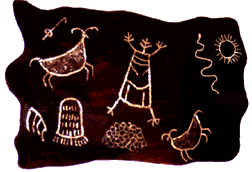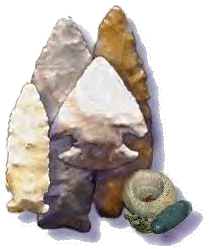 Yokuts Indians arriving some 8,000 years ago were the first Native Americans to settle the fertile San Joaquin Valley. The Kern River flowed through a great marsh of tule grass and cattails where the city of Bakersfield now stands, and Buena Vista Lake, which today is just a remnant of its former self, was a great expanse of water covering tens of square
miles in the center of the valley. A variety of plants that the Yokuts ate grew in the fertile valley soil in the spring and fall when the weather was mild and the ground moist, and oak trees and pine, which were plentiful in the foothills, provided the Yokuts with acorns and pine nuts. The valley in those days was rich with fish and wildlife, and provided plenty of variety for the Yokuts dinner table. When Spanish explorers and missionaries, traveling south from the
Monterey Mission, entered the valley in 1772, they found sixty-three different Yokuts tribes scattered up and down the valley floor, living peacefully off the land.
Yokuts Indians arriving some 8,000 years ago were the first Native Americans to settle the fertile San Joaquin Valley. The Kern River flowed through a great marsh of tule grass and cattails where the city of Bakersfield now stands, and Buena Vista Lake, which today is just a remnant of its former self, was a great expanse of water covering tens of square
miles in the center of the valley. A variety of plants that the Yokuts ate grew in the fertile valley soil in the spring and fall when the weather was mild and the ground moist, and oak trees and pine, which were plentiful in the foothills, provided the Yokuts with acorns and pine nuts. The valley in those days was rich with fish and wildlife, and provided plenty of variety for the Yokuts dinner table. When Spanish explorers and missionaries, traveling south from the
Monterey Mission, entered the valley in 1772, they found sixty-three different Yokuts tribes scattered up and down the valley floor, living peacefully off the land.
 The name Yokuts in their own language means "people", but each tribe had their own name. Yokuts of the southeastern part of the Valley called themselves "Yowlumne" or "Yauelamni", which means "People from the Land of Howlers (Yowlers)", or simply, the "Wolf People". The Spaniards rounded up many Yowlmani, which is the plural form of Yowlumne, along with other Yokuts, and sent them to work the fields of distant missions on the Coast. Many ended up at the Santa Cruz Mission, several days journey from their homeland. Although the Yokuts were plentiful, with some 4500 in the valley and 450 in the Yowlumne tribe alone, diseases and ravages of the white man took their toll so that by 1960 only one full-blooded Yowlumne was left, Wahumcha, a professional maker of bows and arrows, who died in Visalia that year at the age of 97.
The name Yokuts in their own language means "people", but each tribe had their own name. Yokuts of the southeastern part of the Valley called themselves "Yowlumne" or "Yauelamni", which means "People from the Land of Howlers (Yowlers)", or simply, the "Wolf People". The Spaniards rounded up many Yowlmani, which is the plural form of Yowlumne, along with other Yokuts, and sent them to work the fields of distant missions on the Coast. Many ended up at the Santa Cruz Mission, several days journey from their homeland. Although the Yokuts were plentiful, with some 4500 in the valley and 450 in the Yowlumne tribe alone, diseases and ravages of the white man took their toll so that by 1960 only one full-blooded Yowlumne was left, Wahumcha, a professional maker of bows and arrows, who died in Visalia that year at the age of 97.
Wahumcha, last of the Yowlumne Yokuts, talked with Frank Latta, past director of the Kern County Museum, and told him the story of Wo-i-lo, the main village of his people. The name Wo-i-lu means "planting place" or "sowing place", and was given to the village in the Mission era when some Yowlmani acquired farming skills. Although the area was a damp marsh on the east bank of the mighty Kern River, the village of woven tule mat huts sat on a low hill that rose above tule grass and cattails. The Wo-i-lo hill, later called "Reeder Hill" was located in modern Bakersfield along present-day 16th Street, between A and F Streets, but was leveled in the late 1800s when the swamp was filled in to make way for the town. The hill site
today is next to Bakersfield High School where the old train station used to stand. Up river from Wo-i-lu, at a place known as Kern Falls, was K'ono-ilkia ("waters fall"), and at the mouth of Kern Canyon was Shoko ("wind place" in a gorge), the northernmost Yowlumne village.
Because Wo-i-lo was the main Yowlumne village, it was home to their chief, and other high-ranking members of the tribe. Other Yowlumne villages, ruled by sub chiefs, sat in the shadows of the surrounding foothills, extending thirty miles to the south to the Yowlumne village of Tinliu (or Tejon as the place came to be known). This village sat where an Indian trail, known to white settlers as the "grapevine" for wild grapes that grew along its path, starts to climb out of the San Joaquin Valley to a pass over the southern mountains. The U.S. Army built a fort below the pass in the 1860s and named it Fort Tejon, a variation of the Yowlumne name Tinliu.
- North of Woilo, along Poso Creek, lived the Paleumne (Paleayani) Yokuts, who were heavily intermarried with the Yowlumne.
- West of Yowlumne lands, on the west bank of Buena Vista Lake near the modern towns of Taft, Maricopa and McKittrick, lived the Tulumne Yokuts, who collected tar from oil seeps on the west side of the valley for tar balls that they traded to the Yowlumne for waterproofing baskets and boats, securing arrowheads to shafts, and decorating faces and clothes.
- Between the Yowlumne and Tulumne, at now vanished Kern Lake and in tule grass where the Kern River flowed into the lake, lived the smaller tribes of the Halaumne and Tuhoumne Yokuts, who spoke dialects very similar to the Tulumne.
- South and Southwest of the Yowlumne, in the San Emigdio and Topatopa Mountains and running through the Santa Ynez Mountains to Ventura and Santa Barbara on the coast, lived the Chumash---a people of Hokan ancestry who spoke a completely different language than the Penutian tongue of the Yokuts. Despite this language barrier, the Chumash each year allowed the Tulumne Yokuts to enter Chumash lands in the Cuyama Valley to collect thousands of pounds of pine nuts.
- East of Woilo, in the Tehachapi Valley, lived a people of Shoshone ancestry known to the Yokuts as the Kawaiisu. And in the Kern River Valley, above the Yowlumne village of Shoko and near the modern towns of Kernville and Johnsondale, were the Tubatulabal, a different Shoshone people whom the Yowlumne called the "Pitanisha".
These were the villages the Spaniards found when they first arrived, and these were the villages the Yokuts returned to when the missions were closed in the 1830s. However, the onslaught of miners and settlers during the Gold Rush of 1849 brought new trials, and the Yowlumne and other Yokuts were rounded up again in 1851 and sent to former Chumash lands on the Tejon Indian Reservation at Fort Tejon, just north of modern Frazier Park. A band of 400 or so Yokuts resisted in the Tule Indian War of 1856, but were quickly subdued. As the Kern River marsh, which by the 1850s was known as Baker's Swamp, was drained and the Wo-i-lo hill leveled for fill, the Yowlumne began to fade away.
click here for links to more info on
Yokuts Indians